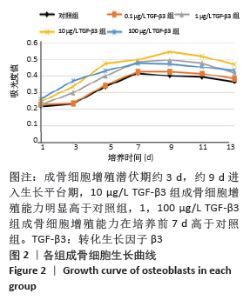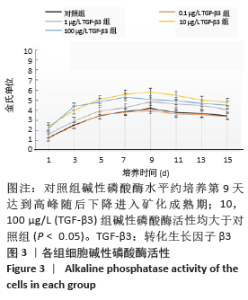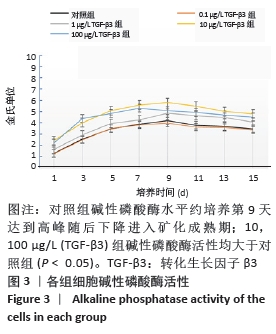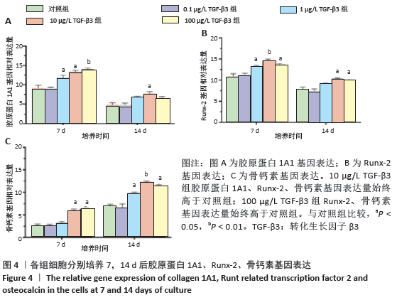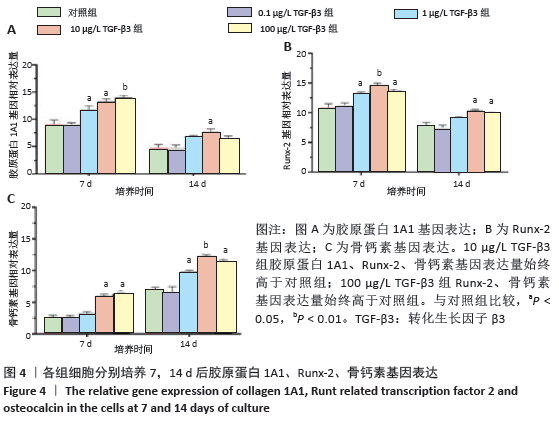[1] FUNDA G, TASCHIERI S, BRUNO GA, et al. Nanotechnology Scaffolds for Alveolar Bone Regeneration. Materials. 2020;13(1):201.
[2] DAVID CJ, MASSAGUÉ J. Contextual determinants of TGFβ action in development, immunity and cancer. Nat Rev Mol Cell Biol. 2018;19(7): 419-435.
[3] 艾力麦尔旦·艾尼瓦尔, 张晓莉, 卡米力江·买买提明, 等.转化生长因子β3促进兔牙髓干细胞成骨向分化的体外实验研究[J].实用口腔医学杂志,2019,35(4):485-489.
[4] 艾力麦尔旦·艾尼瓦尔,李鹏,刁兆峰,等. 幼兔颅盖骨成骨细胞的分离培养及鉴定[J].中国组织工程研究,2019,23(7):996.
[5] VIGNESH U, MEHROTRA D, HOWLADER D, et al. Bone Marrow Aspirate in Cystic Maxillofacial Bony Defects. J Craniofac Surg. 2019;30(3): e247-e251.
[6] AL-MORAISSI EA, OGINNI FO, MAHYOUB HMA, et al. Tissue-engineered bone using mesenchymal stem cells versus conventional bone grafts in the regeneration of maxillary alveolar bone: A systematic review and meta-analysis. Int J Oral Maxillofac Implants. 2020;35(1):79-90.
[7] MESHRAM M, ANCHLIA S, SHAH H, et al. Buccal Fat Pad-Derived Stem Cells for Repair of Maxillofacial Bony Defects. J Maxillofac Oral Surg. 2019;18(1):112-123.
[8] PERPÉTUO IP, BOURNE LE, ORRISS IR. Isolation and Generation of Osteoblasts. Methods Mol Biol. 2019;1914:21-38.
[9] BATLLE E, MASSAGUÉ J. Transforming Growth Factor-β Signaling in Immunity and Cancer. Immunity. 2019;50(4):924-940.
[10] GRAFE I, ALEXANDER S, PETERSON JR, et al. TGF-β Family Signaling in Mesenchymal Differentiation.Cold Spring Harb Perspect Biol. 2018; 10(5): a022202.
[11] 庞海涛,甘洪全,王茜,等.转化生长因子 β1 对多孔钽/MG63 成骨样细胞复合物细胞增殖及分泌功能的影响[J]. 中国组织工程研究,2016,20(25): 3680.
[12] LE M, NARIDZE R, MORRISON J, et al. Transforming growth factor Beta 3 is required for excisional wound repair in vivo. PLoS One. 2012;7(10):e48040.
[13] HUANG L, YI L, ZHANG C, et al. Synergistic Effects of FGF-18 and TGF-β3 on the Chondrogenesis of Human Adipose-Derived Mesenchymal Stem Cells in the Pellet Culture. Food Chem. 2020;330:127212.
[14] LICHTMAN MK, OTEROVINAS M, FALANGA V. Transforming Growth Factors β (TGF-β) Isoforms in Wound Healing and Fibrosis. Wound Repair Regen. 2016;24(2):215-222.
[15] ISMAEEL A, KIM JS, KIRK JS, et al. Role of Transforming Growth Factor-β in Skeletal Muscle Fibrosis: A Review. Int J Mol Sci. 2019;20(10):2446.
[16] 艾力麦尔旦·艾尼瓦尔,木合塔尔·霍加.生长因子诱导牙髓干细胞成骨向分化研究进展[J].中华实用诊断与治疗杂志,2019,33(2): 205-208.
[17] KRSTIC J, TRIVANOVIC D, OBRADOVIC H, et al. Regulation of mesenchymal stem cell differentiation by transforming growth factor beta superfamily. Curr Protein Pept Sci. 2018;19(12):1138-1154.
[18] TSUTSUI TW. Dental Pulp Stem Cells: Advances to Applications.Stem Cells Cloning. 2020;13:33-42.
[19] 艾力麦尔旦·艾尼瓦尔, 木合塔尔·霍加. 转化生长因子β3促进兔牙髓干细胞成骨向分化机制的初步研究[J].口腔医学,2019,39(2):7-12.
[20] LI Y, QIAO Z, YU F, et al. Transforming Growth Factor-β3/Chitosan Sponge (TGF-β3/CS) Facilitates Osteogenic Differentiation of Human Periodontal Ligament Stem Cells. Int J Mol Sci. 2019;20(20):4982.
[21] DENG M, MEI T, HOU T, et al. TGFβ3 recruits endogenous mesenchymal stem cells to initiate bone regeneration. Stem Cell Res Ther. 2017;8(1): 258.
[22] ROEDER E, MATTHEWS BG, KALAJZIC I. Visual reporters for study of the osteoblast lineage. Bone. 2016;92:189-195.
[23] MARUELLI S, BESIO R, ROUSSEAU J, et al. Osteoblasts mineralization and collagen matrix is conserved upon specific Col1a2 silencing. Matrix Biology Plus. 2020:100028.
[24] KOMORI T. Molecular Mechanism of Runx2-Dependent Bone Development. Mol Cells. 2020;43(2):168-175.
[25] KOMORI T. Regulation of Proliferation, Differentiation and Functions of Osteoblasts by Runx2. Int J Mol Sci. 2019;20(7):1694.
[26] GOMATHI K, AKSHAYA N, SRINAATH N, et al. Regulation of Runx2 by post-translational modifications in osteoblast differentiation. Life Sci. 2020;245:117389.
[27] LI SN, WU JF. TGF-β/SMAD signaling regulation of mesenchymal stem cells in adipocyte commitment. Stem Cell Res Ther. 2020;11(1):41.
[28] Suzuki Y, Nakajima A, Kawato T, et al. Identification of Smad-dependent and-independent signaling with transforming growth factor-β type 1/2 receptor inhibition in palatogenesis. J Oral Biol Craniofac Res. 2020;10(2):43-48.
|


